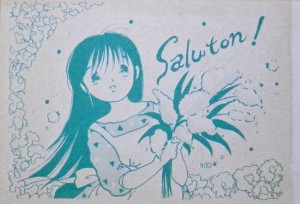Meg Beneville:
Niko-Toma Volunteer Program at Kyoto University Hospital
For my Community Involvement Project, I’ve been volunteering once a week at Kyoto University Hospital through a program called “Niko-Toma”. “Niko-Toma” is a wonderful organization that aims that brighten the lives of children in the hospital, most of whom have serious illnesses and spend long periods of time there.
Niko-Toma plans many fun events for the children, such as holiday parties. My volunteer duties have been extremely varied so far. Many times I help out in the office with the other volunteers, sorting through supplies for future events, folding newsletters or making ornately decorated cards. The other volunteers are most middle-aged Japanese women, who are very warm and welcoming, and chat with me in Japanese while we work. It’s great language practice, and very satisfying to feel like I’ve become a part of the group.
Aside from helping out in the office, I’ve also had some great opportunities to interact with the kids. The Halloween party was absolutely adorable- so many cute kids in costumes, and many parents who were delighted to have such a great photo op. One of the older patients there was a 17 year old girl who I had a fun time talking to. We took a picture together on her phone and exchanged email addresses so that she could send it to me, and we’ve become “internet penpals” since then. She’s very creative and funny, and I hope talking to me is an entertaining distraction that helps to break up the monotony of her hospital stays. I’ve been back to visit her in the hospital and we have fun talking in person as well, although I had to wear a mask since she has a compromised immune system, and this made it more difficult than usual to understand and speak Japanese.
All in all, I’m very happy with my experience at “Niko-Toma”. It’s been very rewarding so far, and I hope my volunteer efforts are making a difference to the kids in the hospital.

